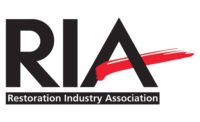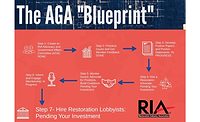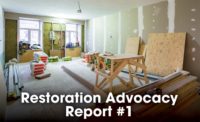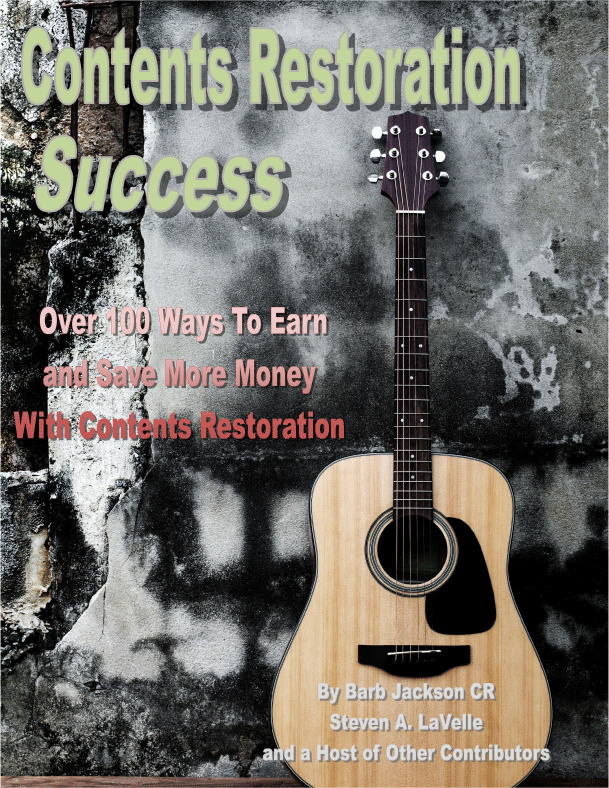Restoration Advocacy Report #3

The Restoration Industry Association (RIA) is riding a powerful wave after its 2019 Convention in Phoenix, which had the highest attendance of any of its conventions in five years. There, the RIA rolled out its Advocacy and Government Affairs (AGA) Committee. The mission of the AGA is to develop and implement strategies to help create and maintain a fair and level playing field, financially and legally, for restoration contractors, by advocating for their interests, while working collaboratively with stakeholders involved in the restoration process. The mission will be pursued aggressively but diplomatically and ethically. The AGA has a specific mission laid out in a seven-step plan, known as the AGA Blueprint.
The AGA has completed the first two steps (creation of the committee, and prioritization of issues following member feedback), and it has made significant progress on step 3 (development of position papers, which will be an ongoing process), as well as step 5 (monitoring of issues and the building of coalitions). Ultimately, the AGA will also engage one or more industry advocates and lobbyists to pursue contractors’ goals and protect their rights. However, the success of this initiative depends on industry support with time, talent and treasure. Every restorer can and should invest at least a small amount of one of those three, if not all three.
The AGA presently has four subcommittees: the Pricing Subcommittee, chaired by Dave Robbins, the TPA Subcommittee, chaired by Ben Looper, the Investment Subcommittee, chaired by Warner Cruz, and most recently, it has formed the TPC (Third Party Consultant) Subcommittee.
PRICING SUBCOMMITTEE REPORT
The AGA Pricing Subcommittee, under the soaring leadership of Dave Robbins, aims to focus the industry’s attention on the inequity of universal pricing models, more specifically challenging Xactware to vigorously promote contractor survey participation through awareness, education and safety from retaliation. While we on the professional restorer side of the industry must understand that it is our responsibility to provide accurate pricing and survey feedback, there must be a greater awareness in the industry that these options are freely available to us. It is also important that users on the insurance side of the industry understand that one size does not fit all. Greater awareness must be the goal if we are to achieve harmony between all materially interested parties (insurers and contractors alike).
"Overhead and profit percentages used at the end of an estimate are not something Xactware sets."
Based on conclusions from the Pricing Subcommittee, as well as the hundreds of years of combined experience of the members of the AGA Committee, AGA’s official position is that 10% for overhead is unrealistic and outdated. In response to an inquiry about why 10% was chosen for overhead and why it has not changed over the years, Greg Pyne, Vice President of Pricing for Xactware has stated in writing: “The overhead and profit percentages used at the end of an estimate are not something Xactware sets. It is something that needs to be determined by the estimator and/or parties involved.” AGA recognizes the limitations contractors face when they voluntarily agree to participate in vendor programs, but wants to banish the notion that 10% is a fair or appropriate percentage for overhead.
The problem is exacerbated because the hourly rates for many trades are not even close to what the marketplace is dictating. The Executive Summary of Xactware’s pricing research methodology paper asserts that its costs data is used more than all of its competitors’ data combined and that its data is the industry standard. It says its Pricing Data Services Team follows a multi-tiered approach by performing industry surveys on both time and material (“bottom up”) and unit costs (“top down”) with more than 50,000 suppliers, contractors and servicers across the continent. In addition, Xactware reviews recent transactions in the form of completed repair and remodeling estimates that have been submitted from live jobs in each market.
Xactware’s February 6, 2018 Pricing Research Methodology report states: “Xactware employs a proprietary cluster analysis algorithm designed by doctorate-level professors with wide experience in the fields of economics and statistical analysis. The cluster analysis algorithm analyzes all submissions, identifies the cluster(s) into which prices are grouped to minimize the impact of outliers, and selects a representative price from the largest cluster. This process is run independently of all other information received.”
Xactware has multiple methods of collecting price data. One of the most prominent methods is Xactware’s reporting tool, XactAnalysis. Xactware’s 2018 Property Report reveals that roughly 90% of the estimates uploaded to XactAnalysis come from adjusters and not from entities that actually perform work in the real world marketplace. The AGA is searching for statistics about Xactware’s other data collection methods, but so far has found none.
“Roughly 90% of the estimates uploaded to XactAnalysis do not come from entities who actually perform work in the real world marketplace.”
Furthermore, the majority of all contractor transaction reviews are program-related uploads through XactAnalysis, most of which are governed, policed and highly scrutinized by the TPAs. In other words, most completed, uploaded estimates have been modified (reduced) before being accepted by the TPAs and/or carriers. Therefore, these estimates are not (necessarily) representative of accurate (or sustainable) pricing models.
Also, based on our review and comparison with the Bureau of Labor Statistics pricing models, Xactimate utilizes the lowest costs available to measure hourly trade rates. Trade rates for restoration workers should rank among the highest paid due to the physical work environment (unstable building conditions, hazards, environmental issues), the time-sensitive nature of the work, the investments employers must make in certifications insurers require for technicians, the unique risk exposure entailed with this type of work and many other factors.
Additionally, there are a number of default settings within Xactimate (such as demolition labor) that should be changed to support the actual trade being performed. This should be changed at the design/platform level, not the user level.
While each of these items are critically important, this is only the beginning. Our overarching goal is to create greater awareness and harmony for everyone, on all sides, while working to ensure that prices are reported accurately.
TPA SUBCOMMITTEE REPORT
The AGA Committee, chaired by Ben Looper, is concerned, among other things, about the TPA file review process. Conflicts arise when contractors receive requests for reductions in price or scope when they believe the requests are not supported by the terms of the program agreement or by insurance repair standards of care. In an effort to reduce these conflicts, and improve communications between contractors and TPAs, the TPA Subcommittee has worked hard to develop a position paper to address this predicament. The goal is to educate all parties involved in an effort to create a smoother claims resolution process. Once approved by RIA’s Board of Directors, it will be RIA’s first-ever position paper. Now that a process is in place, position papers will be easier to produce for RIA and its committees.
The TPA Subcommittee has invested significant energy in formulating a scoring system for TPAs that will allow contractors to make well-informed decisions before agreeing to participate in a program. Doing this properly and fairly is a major undertaking, and the AGA is dedicated to taking the time to do it correctly so that it yields high quality data.
TPC (THIRD PARTY CONSULTANT) SUBCOMMITTEE
The new TPC Subcommittee will address issues with certain third parties that interfere with contractors’ businesses. For purposes of this Subcommittee, a “TPC” is a third party who has no contractual relationship with the contractor, but evaluates contractors’ billing and work and/or provides consultation or adjusting services to insurance companies regarding restoration projects. TPCs include independent adjusters, third party building consultants, commercial loss consultants and construction “experts” who critique restoration invoices. TPAs are not TPCs. Contractors agree to work with TPAs, such as Contractor Connection, by signing up for their programs. TPCs, on the other hand, are imposed upon Contractors without their consent. Therefore, they can––and should––be handled differently.
The TPC Subcommittee will confront the “Monday Morning Quarterbacking” by certain TPCs who attempt to change the rules of the game after it has already been played. Some TPCs make arbitrary allegations about billing norms, for items such as weekly rates, overtime hours and consumables. The Subcommittee will conduct research, formulate winning strategies and eventually publish position papers restorers can use to overcome the most bothersome problems with TPCs.
The founding members of the TPC Subcommittee are Jeff Gross and Tom Peter. The Subcommittee is still in the early formation phase. This is a call for biographies from experienced contractors who are interested in joining this Subcommittee to effect real change across the industry. Please send an email to EdCross@EdCross.com to submit ideas for names or to volunteer.
INVESTMENT SUBCOMMITTEE REPORT
On May 1, 2019, the day the AGA was unveiled, RIA President-Elect/Investment Subcommittee member Mark Springer issued a public challenge to the industry to raise $100,000 for AGA in its first 100 days. We are proud to report that under the fine leadership of Investment Subcommittee Chairman Warner Cruz, this goal was not only met, but shattered—in only 75 days. In fact, as of August 20, 2019, an impressive $127,300.00 has been pledged to the AGA movement by members of our industry, and the number is increasing weekly.
Mr. Cruz is very proud of his entire team for the spirit they showed working the phones in the month of July. He and the AGA extend special thanks and hearty congratulations to Investment Subcommittee member and superstar fundraiser Josh Hobbs of Dalworth Restoration, who was the member who raised the most money in July.

Josh Hobbs
Superstar Fundraiser
The members of the Investment Subcommittee shared a common experience as they called potential investors: All restorers, large and small, conveyed passion and pain from the bullying they experience from TPAs and TPCs who change the rules after work has been completed. Standardized pricing programs are a source of great anxiety. But all restorers get excited about uniting their voices and creating a vehicle where these complaints can be heard and something constructive and sustainable can be done for the sake of the industry. “It is about time someone did something about it” is a common sentiment from the restorers, particularly since the AGA intends to take the proverbial “high road.” This movement is being well received by our industry.
Motivated by its surge of success in July, the Investment Subcommittee has now set its next goal, which is to reach $250,000 by the end of 2019. We wish them the best of luck in this effort. Contractors have suggested a minimum investment of 1/100th of one percent of each restoration company’s annual gross revenue (i.e., $100 per one million in gross revenue), which is very modest. However, most restorers across the country are investing at least $1,000. Please consider investing at least $1,000 as a burst of fuel to help meet our goal by the end of this year.
Mr. Cruz humbly thanks all of the AGA Committee and Subcommittee members in all they do to keep moving the ball forward. He understands how busy everyone is, and is inspired that they find the time to make this a priority. He wishes God’s blessings for all of them.
INVEST IN THE MOVEMENT
From day one, AGA started a powerful grassroots movement with the support and public support of conscientious restorers who want to get involved and make a difference. If you have not already done so, please download your Commitment Card here and email it to me today at EdCross@EdCross.com.
Please join the movement by writing a check payable to “AGA” and sending it to the RIA at 330 N Wabash Ave., Suite 2000, Chicago, IL 60611. Investments are what drives progress, no matter how large or small the investment may be.
I wish to extend special thanks to Dave Robbins, Warner Cruz, Katie Smith and Ben Looper for their valuable contributions to this Report. Thank you, once again, for the opportunity to serve the restoration industry.
Respectfully,
RIA ADVOCACY AND GOVERNMENT AFFAIRS COMMITTEE

Edward H. Cross, Esq., Chairman
Looking for a reprint of this article?
From high-res PDFs to custom plaques, order your copy today!








